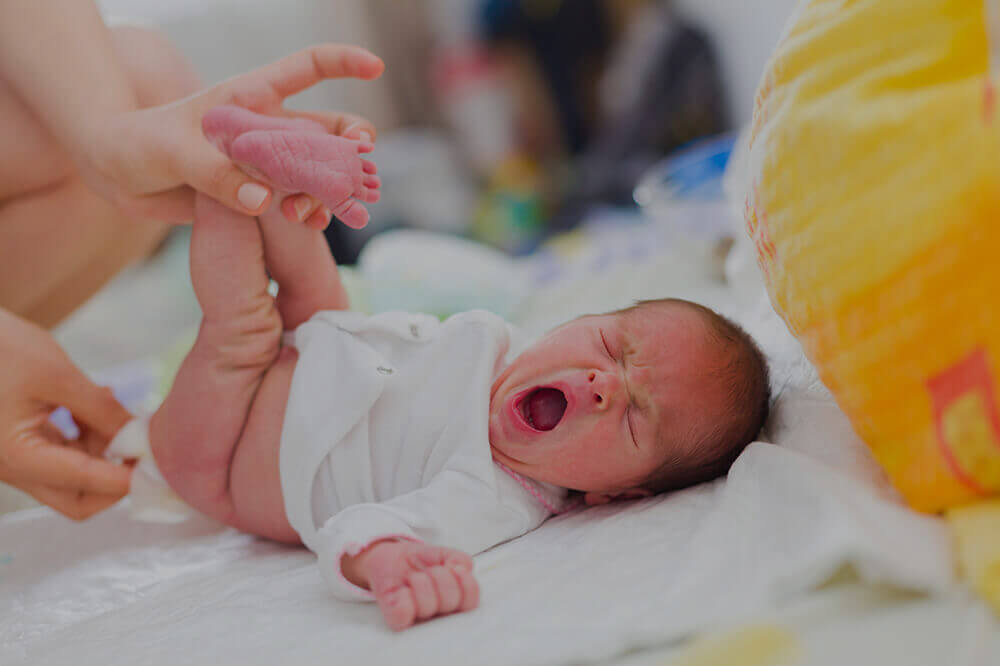Diaper Dermatitis
What is diaper dermatitis?
Diaper dermatitis is an acute inflammation of the baby’s skin in contact with the diaper and it is one of the most common problems during infancy, affecting all races and both males and females equally.
What are the factors causing diaper dermatitis?
Several factors cause the loss of the natural protection barrier of the baby’s skin, thus facilitating the access of irritating agents and microbes, and increasing susceptibility, for instance, to friction.
Some agents like constant moisture, friction, temperature rise, feces and urine, interact and cause an acidity increase in the affected area. They activate fecal enzymes that, added to the fact that the diaper retains feces and urine in contact with the skin, can damage and erode the skin causing inflammation, redness and heat, and in the most severe cases, ulcerations.
At what age does it occur?
It usually appears during the first months of life, more frequently from 6 to 18 months of age.
Are there children more prone to diaper dermatitis?
There are babies more prone to diaper dermatitis, especially those who suffer diarrhea and fecal incontinence, since the higher frequency and volume of depositions and acidity irritate directly the baby’s skin. Patients with dry skin are more prone to skin dermatitis since dry skin is more vulnerable to irritating agents.
What are the manifestations?
Diaper dermatitis ranges from mild cases affecting the buttock area, external genitals and perineal areas, which look reddened and hot, not affecting skin folds.
In moderate cases, the redness is even more intense and bright, with little discharge and slightly affecting folds.
In severe cases, there may be ulcerations of various degrees.
There is a variant called Lucky Luke contact dermatitis affecting the side surfaces where there is no protection effect of the diaper absorbing layer, thus the skin becomes in direct contact with the diaper plastic.
How can it be prevented? What is the applicable treatment?
The key to prevention is trying to keep the skin dry and clean, by moisturizing it and avoiding prolonged contact with feces and urine that damage the skin. This can be achieved by changing the diaper several times during the day and cleaning the baby with oil-based substances.
The use of superabsorbent disposable diapers has reduced the seriousness of diaper dermatitis, because new technologies use materials preventing prolonged contact of the skin with moisture.
These diapers are made of a cellulose core and additional superabsorbent components that, when getting in contact with fluid, form a gel retaining them inside the diaper.
There are diapers with micro pores allowing steam out, and other diapers including zinc oxide to protect the baby’s skin.
No corticoid creams, antifungals or topic antibiotics must be used as preventative treatment due to skin sensitization risk.
Treatment consists in the following:
* Try to keep the compromised area dry, with frequent diaper changes, according to the child’s needs.
* When cleaning the skin in each diaper change, use calcareous oil or mineral oil emulsion; once a day, the baby must be bathed not using irritating soap.
* Try to recover damaged and wet skin using zinc dioxide creams with the property of absorbing water, or once the skin has recovered, use oil-based creams forming a protective layer.
* The use of powder is not recommended, due to aspiration risk.
* You can add the use of antifungal creams, since fungi are often developed; they are usually found in children’s feces and, in case of wounds, they make dermatitis more severe.
What are the complications related to diaper dermatitis?
Diaper dermatitis can get complicated with:
* Bacterial infection characterized by the presence of suppuration and yellowish scabs,
* Generalized mycotic infection caused by a fungus (candida), characterized by the damage to inguinal folds and a marked boundary,
* Residual depigmentation
Based on the above, it can be concluded that in any case of dermatitis the pediatrician or pediatric dermatologist must be consulted, for a quick diagnosis and treatment, taking into account all factors implied in such conditions, and ruling out other types of diseases that may initially appear as diaper dermatitis.
DRA. GRACIELA MANZUR
DR. JOSÉ A MÁSSIMO
ASADEPE (Argentine Pediatric Dermatology Association)

